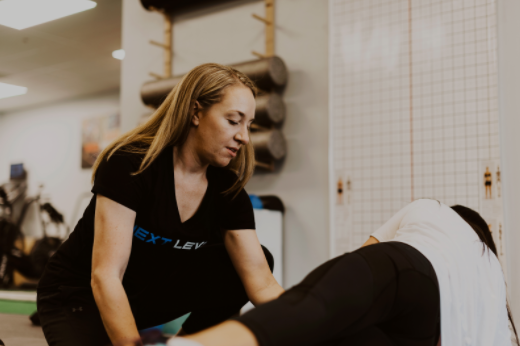Did you know that 60-80% of adults will experience lower back pain during their lifetime? For many, the source of their discomfort can be traced back to a disc bulge or even a herniation in their spine. These two often-confused conditions can lead to persistent pain, nerve issues, and the rollercoaster of frustration that follows. But here’s the good news: whether you’re dealing with a L4-L5 disc bulge, a circumferential disc bulge, or anything in between, understanding your symptoms and acting early can make all the difference.
Buckle up. The physical therapists at Next Level Physical Therapy are about to explore what disc bulges are, their symptoms, how they differ from herniated discs, and what you can do to protect your spine and live pain-free.
Anatomy 101: What Is a Disc Bulge?
Picture a jelly donut. That’s basically what the discs in your spine look like. These cushions sit between the bones in your back (vertebrae) and act as literal shock absorbers. The outside layer of each disc, called the annulus, is tough and fibrous, while the inside, the nucleus, is soft and jelly-like.
Now imagine squeezing that jelly donut just a little too hard. The jelly inside starts to press against the outer walls, pushing them outward. That’s a disc bulge in action. The outer layer remains intact, but it’s under strain. However, when too much pressure is applied and the jelly leaks out, you’ve got yourself a herniated disc.
Common Disc Bulge Hotspots
- L4-L5 Disc Bulge: Found in the lower back, this spot takes on most of your body weight and movement, making it a common trouble zone.
- Circumferential Disc Bulge: This type of bulge isn’t isolated to one section of the disc but affects its entire circumference, potentially leading to widespread nerve compression.
Disc Bulge vs. Herniation
A disc bulge and a herniated disc might sound similar, but they have key differences. Disc bulges happen when the jelly inside the disc pushes outwards without breaking the outer layer. A herniated disc, on the other hand, involves a tear in the outer layer, causing the jelly to escape and often irritate nearby nerves.
Here’s why this matters:
- Disc bulges are more gradual and may cause mild discomfort that worsens over time.
- Herniations tend to cause sharper, more severe pain, often leading to noticeable nerve symptoms like tingling or weakness.
If you’ve been experiencing back pain, it’s crucial to get an accurate diagnosis to determine whether you’re dealing with a disc bulge or herniation, as treatments will differ.
Symptoms of a Disc Bulge
How do you know if you’re experiencing symptoms of a disc bulge? For starters, they love making themselves known through:
- Persistent lower back pain.
- Pain that radiates into your buttocks or legs (sciatica).
- Tingling, numbness, or weakness in your legs or feet.
- Pain that worsens when bending, twisting, sitting, coughing, or sneezing.
It’s easy to dismiss these symptoms as minor inconveniences, but ignoring them can make the situation worse. If you suspect you have a diffuse disc bulge or specific pain in areas like L4-L5, don’t wait to seek help.
Spotting the Warning Signs
Meet John. He’s a father, a lawyer, and an avid golfer. A month ago, John noticed a tingly feeling in his foot. He brushed it off. A few weeks later on the golf course, he felt a twinge in his buttock after lifting the flag. Again, he ignored it. Then one morning, John bent down to put on his socks, and BAM! A sharp pain shot through his leg. By the end of the day, he couldn’t stand up straight.
To his surprise, the doctor focused on his back, not his leg. One MRI later, the diagnosis was clear: a bulging disc.
Don’t be like John. Addressing early symptoms like tingling or slight pain can save you from escalating problems (and possibly surgery).
What to Do About a Disc Bulge
The good news? Disc bulges are often treatable, and surgery is rarely necessary. Here’s a rundown of effective disc bulge treatment options:
At-Home Remedies
- Ice and Heat Therapy: Start with ice to reduce inflammation, then switch to heat after 48 hours to improve blood flow and relax the muscles.
- Press-Up Exercise: Lie on your stomach and push your upper body upward, keeping your hips on the floor. This simple move can help reduce the bulge by easing pressure off the disc.
Medical Treatments
- Physical Therapy: Personalized exercises to strengthen your core and stabilize your spine, reducing pressure on the bulging disc.
- Medication: Over-the-counter options like ibuprofen can help manage inflammation and pain.
- Steroid Injections: If the pain is severe, targeted injections can calm inflammation and provide temporary relief.
Prevention Is Your Best Defense
While you can’t prevent every disc issue, there’s a lot you can do to improve your spine’s resilience. Here are a few tips:
- Watch Your Posture: Whether sitting, standing, or lifting, good posture is your spine’s best friend.
- Exercise Regularly: Focus on your core and back muscles to provide better support for your spine.
- Lift Properly: Bend your knees, not your back, when picking up heavy objects.
- Quit Smoking: Smoking accelerates disc degeneration, so quitting is one of the best things you can do.
Don’t Ignore the Signs
If you’re asking, “Is disc bulge curable?”, the answer largely depends on how quickly you act. Treating a disc bulge early can:
- Shorten recovery time.
- Prevent chronic episodes.
- Reduce the risk of needing surgery in the future.
If you’ve been dealing with odd sensations, recurring pain, or nerve-related symptoms, listen to your body. It’s trying to tell you something.
Take the First Step to Relief
Still wondering if your pain is due to a disc bulge or another issue? Don’t gamble with your health. Talk to a healthcare professional or physical therapist who can guide you toward the right diagnosis and treatment.
And if you’re looking for more support, schedule a consultation to take the first step toward a pain-free life. Your spine will thank you.
From prevention tips to disc bulge treatment, every step you take today is an investment in a healthier, happier tomorrow. Don’t wait. Start now.





